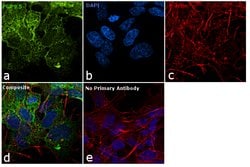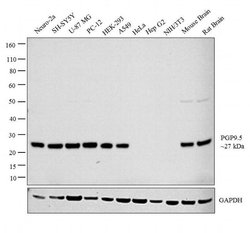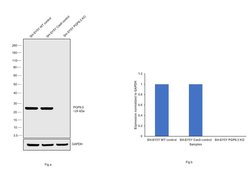Learn More
Invitrogen™ PGP9.5 Monoclonal Antibody (31A3)
Mouse Monoclonal Antibody
Supplier: Invitrogen™ MA183428
Description
This antibody does not react with guinea pig. This antibody is suitable for use on paraffin-embedded tissue sections, with a recommend fixation in 95% ethanol/5% acetic acid for 2-3 hours prior to paraffin-embedding. Specimens which have not been fixed in acetic acid/alcohol will likely require pretreatment using the microwave-citrate buffer method. Mouse anti Human Protein Gene Product 9.5 antibody, clone 31A3 recognizes protein gene product 9.5 (PGP9.5), a ubiquitin hydrolase which is widely expressed in neuronal tissues and represents 1-2% of total soluble brain proteins.
PGP9.5 (Protein gene product 9.5, UCH-L1, PARK5) is a neuron specific protein, structurally and immunologically distinct from neuron specific enolase. PGP9.5 has a molecular weight of 27 kDa and was first identified by high resolution two dimensional PAGE. PGP9.5 is a member of ubiquitin carboxyl-terminal hydrolase family 1 (peptidase family C12) with a ubiquitin carboxyl-terminal hydrolase domain. PGP9.5 is well known for having ubiquitin hydrolase and ligase activities that hydrolyzes small C-terminal adducts of ubiquitin to generate ubiquitin monomers. PGP9.5 is present in neurons and nerve fibers at all levels of the central and peripheral nervous system, in neuroendocrine cells, in segments of the renal tubules, in spermatogonia and Leydig cells of the testis, in ova and in some cells of both the pregnant and non-pregnant corpus luteum. Over expression of PGP9.5 leads to non-small cell lung cancer while decreased expression leads to Huntington disease and Alzheimer disease. Since PGP9.5 is present in cellular inclusions, it can be a useful as a neuronal marker and in the studies of neurodegenerative disorders such as with Parkinson disease.
Specifications
| PGP9.5 | |
| Monoclonal | |
| 1 mg/mL | |
| PBS with 0.09% sodium azide; pH 7.2 | |
| P09936, Q00981, Q9R0P9 | |
| Uchl1 | |
| Native protein, from brain. | |
| 200 μg | |
| Primary | |
| Human, Mouse, Rat, Rabbit | |
| Antibody | |
| IgG1 |
| ELISA, Immunohistochemistry (Paraffin), Western Blot, Immunocytochemistry | |
| 31A3 | |
| Unconjugated | |
| Uchl1 | |
| AW822034; C88048; epididymis luminal protein 117; epididymis secretory protein Li 53; gad; gracile axonal dystrophy; HEL-117; HEL-S-53; MGC133697 protein; NDGOA; neuron cytoplasmic protein 9.5; OTTHUMP00000218137; OTTHUMP00000218139; OTTHUMP00000218140; OTTHUMP00000218141; PARK5; PGP 9.5; PGP9.5; PGP95; protein gene product 9.5; R75593; ubiquitin carboxyl-terminal esterase; ubiquitin carboxyl-terminal esterase L1 (ubiquitin thiolesterase); ubiquitin carboxyl-terminal hydrolase isozyme L1; ubiquitin carboxyl-terminal hydrolase L1; ubiquitin carboxy-terminal hydrolase L1; ubiquitin C-terminal hydrolase; ubiquitin C-terminal hydrolase 1; ubiquitin C-terminal hydrolase L1; ubiquitin thioesterase L1; ubiquitin thiolesterase; ubiquitin thiolesterase L1; UCHL; UCHL1; UCH-L1; UCHL-1 | |
| Mouse | |
| Protein A | |
| RUO | |
| 100357806, 22223, 29545, 7345 | |
| Store at 4°C short term. For long term storage, store at -20°C, avoiding freeze/thaw cycles. | |
| Liquid |
Your input is important to us. Please complete this form to provide feedback related to the content on this product.


